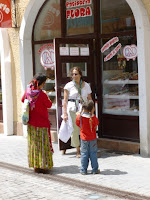21 June 2012
21 June 1934
Forio d'Ischia, Italy
 |
| Forio |
 |
| Jane waits for sunset |
Two solstices, 78 years apart. The sun is about to set from the balcony of the Villa Ravino, overlooking the azure sea. It is almost enough to ignore the heat wave; to ignore the hair raising taxi ride through central Naples to get to the ferry to the island of Ischia.
In 1934, my mom described some of it much as I would today, though she arrived by steamship and not by train:
"The Bay of Naples is a beautiful sight...
When Naples itself came into view, Mt. Vesuvius could be seen as plain as day. It was steaming on the top. We finally docked and you never did see such a sloppy place as the Naples waterfront. Honestly, I was so disgusted I felt like crying. We planned to go to Forio, so while we waited for the little boat, Mr. D'Abundo [a relative] took us around Naples in a crazy little taxi."
Marie DiMeglio
 |
| Forio |
Our arrival in Naples yesterday was little different, though our friend and driver Valerio from San Gregorio negotiated the chaos with an expertise one could only applaud. Our reaction was much like my moms. We got to the boat, bought our tickets to Forio and were delighted to depart Napoli. Our destination was the Villa Ravino, another fortuitous internet selection set on the top of a hill overlooking the bay. With its pool and thermal pool and whitewashed verandas, and its incredible garden, I must confess that it was hard to get on with the search for family this morning.
Mom was not as charmed with Forio, her dad and mother's birthplace, as I was:
16-21 June 1934
"It's the most ridiculous looking place I ever saw and the small stone houses are enough to disgust anyone...We were met by the whole town...we went to see the church of Saint Vito...we met Pasquale DiMeglio, dad's cousin..he was swell. I couldn't sleep last night, it was so hot. I went swimming down at the beach. The water was beautifully clear... At about 12 o'clock a carriage came from us and we went and had dinner. then a car...the only one in Forio..came and we went driving all over the island.. to Ischia, Cassamicola and other little towns. They were all much better than Forio."
21 June 2012
Perhaps you are getting the sense that mom was a bit of an adolescent brat? Most of her diary describes the boys she went dancing with when they came back in August to stay for a month, and were saved from staying with the relatives in Forio. I went searching for the offspring of those same relatives this morning.
Spoiled by the experience in San Gregorio, I walked into town, coming first upon the church of St. Vito. I was looking for the grave of grandpa's uncle, a Franciscan bishop and honored son of Forio. I have a picture of the family and "tio vescovo"... uncle bishop, as he signs himself. I knew he was buried in one of the town's many churches. From St. Vito's I made my way to the cemetary, where I found the grave of grandpa's brother SSalvatore, and of the same Mr. D'Abundo that mom mentions. When I finally made my way to the municipal offices, the clerk;s first response was "which DiMeglios?" We finally connected trilingually over the bishop and she contacted his only living relative left, who is an exceedingly distant cousin of mine. Will try again for DiMeglios tomorrow.
 |
| Gail reads by pool |
As mom said, it is hot hot hot, so I was happy to rejoin Jane and Gail in the pools and extensive gardens of the Villa Ravino. Could these be the same gardens mom visited in 1934?
 |
| sunset on Solstice 2012 |
We elected not to go out for food, but watched the sun go down, hoping to see the famous green flash of Ischia. The salami, ricotta, cannoli, pizza grano, tomatoes, melons and bread from the market works fine for me!






























